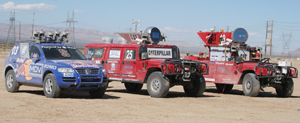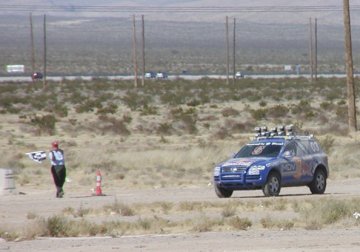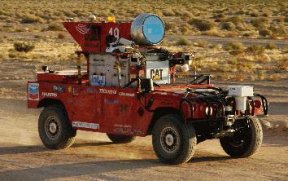Robots on the Road, Again
Five driverless vehicles completed a 130-mile race across rugged desert terrain.
By Emily Sohn
Oh, what a difference a year can make.
 |
|
The top three finishers in the 2005 Grand Challenge race for driverless vehicles (from left to right): Stanford University’s 2004 Volkswagen Touareg sports utility vehicle (nicknamed Stanley) and Carnegie Mellon University’s pair of Humvees, Highlander and Sandstorm. |
| Carnegie Mellon University |
Last year, 15 teams made it to the finals of the first Grand Challenge, a 142-mile (228-kilometer) road race across the desert (see “Robots on a Rocky Road“).
Any type of vehicle could enter the contest, but there was one big twist. Drivers were not allowed. Neither were passengers nor remote controls. Vehicles had to drive themselves over rugged terrain and around obstacles, with no help from people. None of the entries made it.
After watching vehicle after vehicle stall, crash, or burn, competitors refined their strategies and learned their lessons. This year, five out of the 23 finalists completed the 130-mile (210-kilometer) course through the Mojave Desert along the California-Nevada border.
 |
|
About to cross the finish line, the driverless vehicle dubbed Stanley traversed more than 200 kilometers of rough terrain without human assistance.
|
| D. Orenstein/Stanford |
The winner of the $2 million prize was a blue 2004 Volkswagen Touareg sports utility vehicle, nicknamed Stanley. Customized by researchers at Stanford University with help from industry partners such as Volkswagen, Stanley easily beat a 10-hour time limit on the race. It breezed past the finish line in just under 6 hours, 54 minutes, and its average speed was slightly more than 30 kilometers per hour (19 miles per hour). At times, it topped 60 kilometers per hour (37 miles per hour).
Two vehicles developed by Carnegie Mellon University, Highlander and Sandstorm, came second and third. An earlier version of Sandstorm had competed in the first race and had traveled farther than any other entry.
 |
|
Race veteran Sandstorm finished third in this year’s Grand Challenge.
|
| Carnegie Mellon University |
A U.S. government agency called the Defense Advanced Research Projects Agency (DARPA) created and sponsored the Grand Challenge. Given a boost by DARPA’s race, robotic vehicle technology is coming closer to fulfilling a government requirement that one-third of future army vehicles be driverless. The military would like to find better ways to transport goods during wartime without endangering soldiers.
This year’s resounding success was a result of recent advances in sensors and computer software, experts say. Stanley had five laser-beam sensors on its roof. It also had a specialized system for avoiding obstacles that was trained on data collected as human drivers navigated the car over a variety of terrain.
Soldiers aren’t the only ones who stand to benefit from the new technology. Someday, all cars and trucks might incorporate similar strategies to make our own road adventures safer and easier.—E. Sohn
Going Deeper:
Weiss, Peter. 2005. Road warriors: Robotic vehicles triumph over desert obstacles. Science News 168(Oct. 15):244. Available at http://www.sciencenews.org/articles/20051015/fob3.asp .
Sohn, Emily. 2004. Robots on a rocky road. Science News for Kids (April 21). Available at http://www.sciencenewsforkids.org/articles/20040421/Feature1.asp .
You can learn more about the DARPA Grand Challenge at www.darpa.mil/grandchallenge/ or www.grandchallenge.org/ (U.S. Defense Advanced Research Projects Agency).
The Stanford University team has a Web site at www.stanfordracing.com/ (Stanford University).
The two Carnegie Mellon University teams have a Web site at www.redteamracing.org/ (Carnegie Mellon University).







